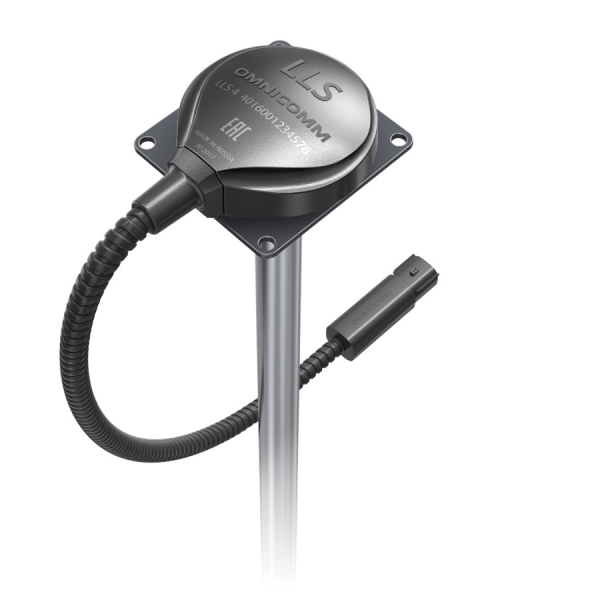OMNICOMM LLS4 FUEL LEVEL SENSOR
Omnicomm’s digital data transmission protocol has become the de facto industry standard in capacitive fuel-level sensors globally. Omnicomm’s sensors include the LLS 4, the LLS-AF 4 and the explosion-proof LLS 20230.

Fuelling Your Business
For every business that operates a fleet of vehicles – be they trucks, locomotives or ships – having a handle on fuel costs is critical. Fuel is literally
the driving force across every mile, and in many regions accounts for the single biggest slice of operational expenditure. Finding ways to cut fuel
costs is a priority
Fuel Monitoring Matters
Telemetry and capacitive fuel-level sensors lie at the heart of effective fuel monitoring, empowering fleet operators to monitor fuel consumption, mileage in km per litre and precise fuel levels at any time. Capacitive sensors are highly accurate and reliable, with a long work- life, and require no technical maintenance. Standard fuel sensors in trucks, for example, simply aren’t consistent or accurate enough.
How It Works:Easy Installation
Omnicomm’s sensors are designed for easy set-up and calibration by technicians even in field conditions using the mobile calibration station.
Requiring just the starter kit and a laptop running the Omnicomm Configurator, the technician prepares the tank, cuts (if required) and calibrates
the fuel sensor, mounts the sensor and then calibrates the fuel tank. The sensors are then connected to the Omnicomm or third-party terminal,
ready to start logging and monitoring fuel data.
The whole process is straightforward and should take no more than between one and four hours. If necessary, Omnicomm provides training,
guidance and support every step of the way.
Powerful Benefits
| Extreme accuracy of 99.2% | Consistently high reliability, even in extreme temperatures |
|---|---|
| Tamper-proof body for extended reliability and durability | Our sensors are suitable for most fuel tanks (minimum sensor length 150mm, default sizes 700-6000 mm, with the option to shorten to fit the exact tank size even in the field – no special equipment needed) |
| Eliminate data noise with Omnicomm’s unique data filtering algorithm | Wide application area – our sensors can be fitted to tanks on vehicles of virtually any description, on land and on sea and across multiple industries |
| Built-in 1500V galvanic isolation for powerlines and communication interfaces protects the sensors and sensor operation in the event of sudden increases in voltage, even in vehicles with no additional galvanic isolation units | Consistently high quality of all components, internal and external, is achieved as a result of standardized quality controls maintained across all stages of manufacture from our own manufacturing facilities in Moscow and the EU (ISO certification ISO 9001:2015) |
| The quality of components, manufacture and support means that Omnicomm sensors have an extended product lifetime and are fully guaranteed | The quality and reliability of our sensors are validated by multiple deployments internationally |
| Fully certified across the board: E-mark, CE, FCC, EAC | Compatible with third-party on-board terminals |
Specifications
| Paramater | LLS 4 |
|---|---|
| Size, mm | 700, 1000, 1500, 2000, 2500, 3000 |
| Error in measurement, % | ± 1,0 % |
| Output | RS-232, RS-485 |
| Programmable baud rate, bit/s | 2400, 4800, 9600, 19200, 38400, 57600, 115200 bit/s |
| Power supply voltage, V | 7...80 V |
| Current consumption, max, mA | 40 |
| Power consumption, max, W | 0,4 |
| Ingress protection rating | IP69k |
| Dielectric strength of galvanic isolation, min, V | 1500 |
Operating Conditions
| Operating temperature, C | -60 ... +85 |
|---|---|
| Relative humidity at 25 °С, % | 5 ... 95 |
| Air pressure, kPa | 84 ... 107 |
| Maximum allowed humidity level, % | 100 |
| Resolution, bit | 12 |
| Output range of readings corresponding to the maximum value of measured level | 1...4095 |
| Output range of readings corresponding to the minimum value of measured level | 0...1023 |
| Temperature measuring range, C | - 40 ... + 80 |
| Absolute error in temperature measurement within the operating temperature range, C | ± 2 |
| Measurement frequency, s | 1 |
| Interval of automatic data output, s | 1 ... 255 |
| Size of internal filter of measurement results, points | 0 ... 30 |
| Operation mode | Continuous |
| Average service life, years P | 8 |